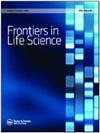Epigenetics: from the past to the present
Q1 Biochemistry, Genetics and Molecular Biology
引用次数: 32
Abstract
ABSTRACT The definition of epigenetics is still under intense debate; however, its concept has evolved since it was originally introduced in 1939 by Conrad Hal Waddington as a way to reconcile antagonistic views between the school of preformationism and the school of epigenesis. The characterization of a large number of phenomena that diverge from the dogmas of classical genetics, and the discovery of the molecular mechanisms through which these phenomena occur, has given rise to a new area of study with important implications for biological sciences. Interactions between the environment and the DNA through modifications on the chromatin are not only responsible for the expression of a normal phenotype, these may be involved in the development of various pathologies. The epigenome, as the bridge between the genome and the phenotype, is no doubt one of the most interesting current ideas in genetics and is so revolutionary that it may change our present notions about inheritance and evolution. In this review, we made a compilation of the most important events in the history of epigenetics, its implications and some perspectives to the future. Abbreviations: DNA: deoxyribonucleic acid; RNA: ribonucleic acid; DNMT: DNA methyltransferase; MBP: methyl-CpG-binding proteins; HAT: histone acetyltransferase; HDAC: histone deacetylase; SAM: S-adenosyl methionine; ncRNA: non-coding RNA; rRNA: ribosomal RNA; miRNA: microRNA; siRNA: small interfering RNA; piRNA: Piwi-interacting RNA; XiRNA: X-inactivation RNA; lncRNA: long non-coding RNA; GR: glucocorticoid receptor; IGF2: insulin-like growth factor II; HPA: hypothalamic–pituitary–adrenal; TSA: trichostatin A; LINE: long interspersed nuclear elements; LOI: loss of genomic imprinting; MAS: McCune–Albright syndrome; AS: Angelman syndrome; PWS: Prader–Willi syndrome; FDA: Food and Drug Administration; AHEAD: International Human Epigenome Project; HEP: Human Epigenome Project; TMG: thiomethyl-β-D-galactoside表观遗传学:从过去到现在
表观遗传学的定义仍然存在激烈的争论;然而,自1939年康拉德·哈尔·沃丁顿最初提出它以来,它的概念已经演变,作为调和预形成主义学派和表观发生学派之间对立观点的一种方式。对大量偏离经典遗传学教条的现象的描述,以及对这些现象发生的分子机制的发现,已经产生了一个对生物科学具有重要意义的新研究领域。环境和DNA之间通过染色质修饰的相互作用不仅负责正常表型的表达,这些可能涉及各种病理的发展。表观基因组作为基因组和表现型之间的桥梁,无疑是当前遗传学中最有趣的观点之一,它是如此具有革命性,以至于它可能会改变我们目前关于遗传和进化的观念。本文综述了表观遗传学发展史上的重要事件,并对其发展前景进行了展望。缩写:DNA:脱氧核糖核酸;RNA:核糖核酸;DNMT: DNA甲基转移酶;MBP:甲基cpg结合蛋白;HAT:组蛋白乙酰转移酶;HDAC:组蛋白脱乙酰酶;SAM: s -腺苷型蛋氨酸;ncRNA:非编码RNA;rRNA:核糖体RNA;microRNA:微;siRNA:小干扰RNA;piRNA: piwi相互作用RNA;XiRNA: x -失活RNA;lncRNA:长链非编码RNA;GR:糖皮质激素受体;IGF2:胰岛素样生长因子II;HPA:肾上腺;TSA: trichostatin A;LINE:长散布的核元素;LOI:基因组印迹丢失;MAS: McCune-Albright综合征;AS: Angelman综合征;PWS:普瑞德-威利综合征;FDA:食品和药物管理局;国际人类表观基因组计划;人类表观基因组计划;TMG: thiomethyl -β-D-galactoside
本文章由计算机程序翻译,如有差异,请以英文原文为准。
求助全文
约1分钟内获得全文
求助全文
来源期刊

Frontiers in Life Science
MULTIDISCIPLINARY SCIENCES-
CiteScore
5.50
自引率
0.00%
发文量
0
期刊介绍:
Frontiers in Life Science publishes high quality and innovative research at the frontier of biology with an emphasis on interdisciplinary research. We particularly encourage manuscripts that lie at the interface of the life sciences and either the more quantitative sciences (including chemistry, physics, mathematics, and informatics) or the social sciences (philosophy, anthropology, sociology and epistemology). We believe that these various disciplines can all contribute to biological research and provide original insights to the most recurrent questions.
 求助内容:
求助内容: 应助结果提醒方式:
应助结果提醒方式:


